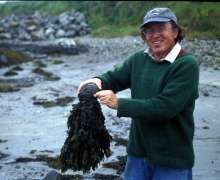Joseph Kelley
Address: Department of Earth Sciences, University of Maine, Orono, ME 04469-5790
Bio:
I am centrally interested in the response of shoreline environments, and their inhabitants to changes in relative sea level. I work on beach erosion issues from both scientific and management perspectives, and have been closely involved with creation of Maine’s sand dune laws. I am also interested in erosion along more sheltered shorelines where bluff erosion can be a chronic problem. I developed a bluff mapping program in Maine that led to a set back ordinance. Salt marshes and adjacent freshwater, tidal wetlands are also a focus of mine. I am interested in the dynamics of marsh surfaces as they confront rising sea level.
I use geophysical tools (side scan sonar, seismic reflection, multibeam) to map seafloor environments. I work in estuaries and on shelves that were once terrestrial and core into deposits that allow measrement of sea-level rise. I have also worked on archeological sites presently submerged as well as those in modern-day coastal settings.
I am interested in sediment, its texture and mineralogy as well.
I have worked largely in Maine, but also in Northern Ireland, Portugal, Alaska and Louisiana.
Research Area:
I am working with Dan Belknap, Cyndy Loftin and our graduate student, Margot Mansfield, on a Sea Grant-sponsored project to measure the rate(s) of freshwater wetland retreat and replacement by marine environments (salt marshes, tidal flats and beaches). This project will have room for an undergraduate in the summer of 2011.
Dan Belknap and I and colleagues from Northern Ireland, the Republic of Ireland and England are funded to begin a three-year study of sea-level change in the Irish Sea. This will involve multibeam and seismic reflection, as well as coring of lower-than-present landforms related to lower sea level. Modeling will follow this work. At present, this UK-funded project has no US graduate students, but we are working to see if we can put a student on this.
Alice Kelley and I, along with colleagues from Bates College, USM and UK universities are working on a NSF-sponsored study in the Shetland Islands. There a community was buried by drifting coastal sand dunes in the Middle Ages. We plan to use ground-penetrating radar (GPR) to find this community and possibly indicators of what caused the sand to become active. We have room for a graduate student or an undergraduate to work on this expedition. It is funded through 2013.
Alice, Keley, Dan Belknap, Dan Sandweiss and graduate and undergraduate students from UMaine are working to use GPR to reveal a monumental structure buried on a raised Holocene shoreline in northern coastal Peru. We completed field work in 2010 and hope complete our analyses by 2011.


